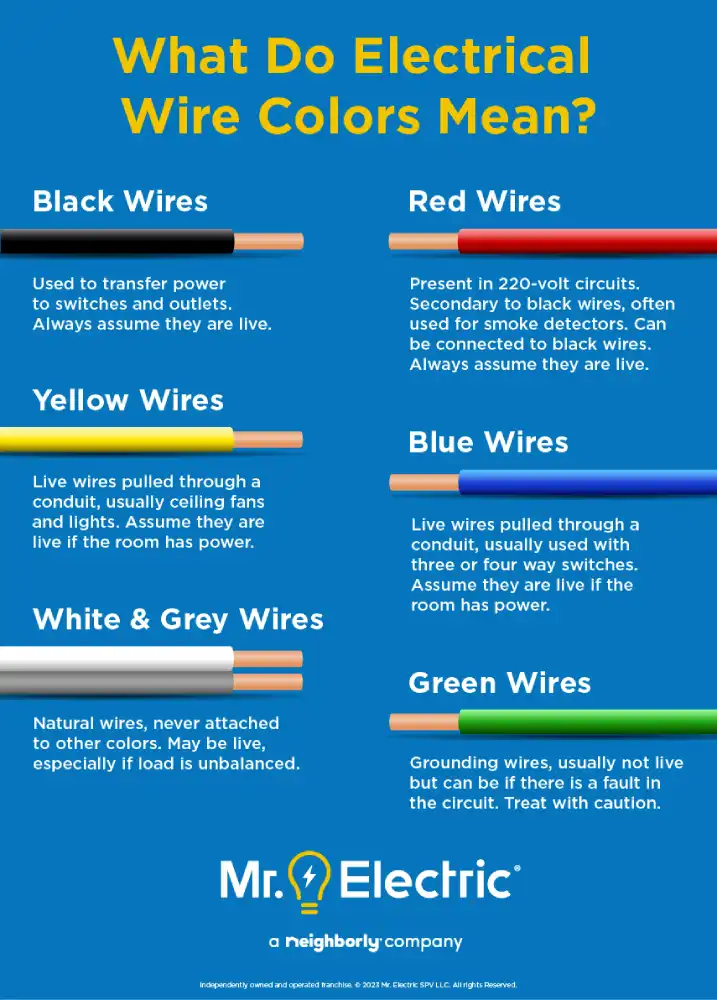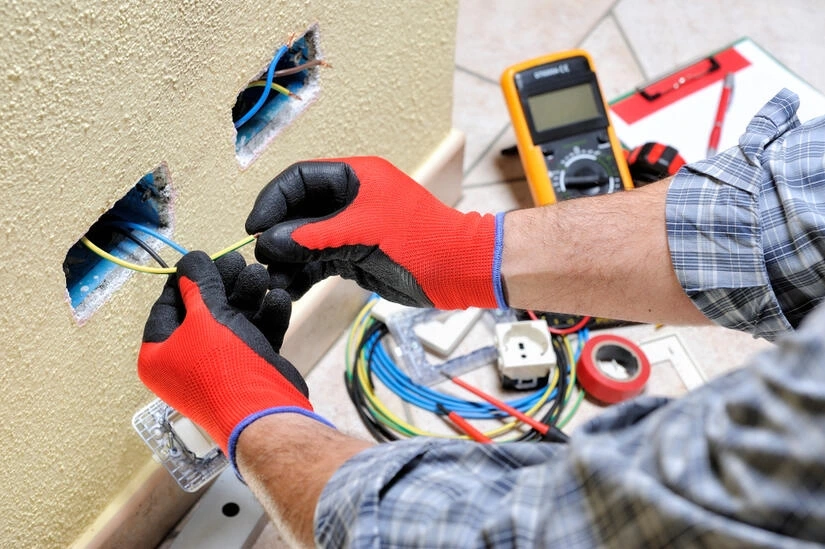If you live in the United States and your home was built after the 1940s (or your outdated wiring has since been updated), you can expect to find certain electrical wire colors behind your walls. Specific colors identify each wire’s function in a circuit. Learning these residential electrical color codes before attempting any type of do-it-yourself (DIY) electrical system repair is critical.
Just remember, all wires could carry a current at some point, so treat every electrical wire color with equal caution. If you have any hesitations, leave electrical installation and upgrades or electrical repairs to one of our qualified professionals.
Why Electrical Wire Colors Matter
Electrical wire colors are essential for safety, clarity, and compliance. Whether you’re a trained electrician or a homeowner replacing a light switch, understanding what each color means can help prevent electrical hazards and ensure your system operates the way it should.
Safety first
Wire colors indicate which wires are hot, neutral, or grounded. This is a critical part of electrical safety. Accidentally touching or miswiring a live (hot) wire could result in shocks, fires, or worse. Color coding takes the guesswork out of the process, helping you identify the right wires at a glance.
Code compliance
The National Electrical Code (NEC) sets the standard for electrical installations in the U.S., and color coding plays a big role in that. Using the correct colors ensures your wiring follows code, which is especially important for inspections and insurance purposes. Improper color use could delay a project—or make it outright dangerous.
Easier troubleshooting
When something goes wrong, electrical wire colors speed up the diagnostic process. Whether you’re dealing with a tripped breaker, flickering lights, or an outlet that’s gone dead, being able to identify the function of each wire by color helps professionals and DIYers alike zero in on the issue faster.
Universal understanding
Because electrical systems often involve more than one person over time—installers, inspectors, maintenance crews, and future homeowners—wire colors offer a universal language. Even if you weren’t the one who did the wiring, standardized colors help ensure you’re not walking into a mystery.
Preventing crossed connections
Mixing up hot, neutral, and ground wires is a recipe for trouble. Using consistent wire colors helps prevent accidental cross-connections, which can cause electrical devices to malfunction or pose safety risks. It also helps ensure everything is connected properly the first time.
Now, let's look at the meaning of each color.

What Do Electrical Wire Colors Mean?
Electrical wire colors might look simple, but they serve a very specific purpose. Each color follows the national standard to help make electrical systems safer and easier to work with. Always turn off power at the breaker before working with wiring and consult a licensed electrician if unsure about what each color tells you.
Black electrical wires
Black wire is typically used to transfer power to switches and outlets in all types of circuits. Also, black wires are often used as switch legs in circuits, which is the connection linking a switch to the electrical load. Consider all black wires to be live at all times.
Red electrical wires
In 220-volt circuits, red wires are the secondary live wires. Like black wires, red wires can also be used in switch legs. In addition, red wires are used to connect hardwired smoke detectors to the home’s power system. It’s possible to link two red wires together or a red wire to a black wire. Consider all red wires to be live at all times.
Blue and yellow electrical wires
While wires in these colors carry power, blue or yellow wires are not used in typical outlet wiring. Instead, blue and yellow wires are used as the live wires pulled through a conduit. For example, you might see yellow wires as switch legs to ceiling fans, structural lights, and outlets paired with light switches. Then, blue wires are most often used by travelers for three- or four-way switches (for instance, if you have switches at the top and bottom of a staircase that controls the same light, that’s a three-way switch).
White and gray electrical wires
If you find either white or gray electrical wire colors, you’ve located the neutral wires. White is most commonly used, but gray wires serve the same function. The purpose of a neutral wire is to connect to the neutral bus bar, a conductive piece of metal within an electrical panel that attracts the electric current for distribution throughout the house. White and gray electrical wires can only be connected. While they’re called “neutral” wires, they may still carry a current, especially if the current load in the circuit is unbalanced, so handle these wires cautiously.
Green electrical wires
The purpose of green wires is to ground an electrical circuit. Green wires connect to the grounding terminal in an outlet box and run to the ground bus bar in an electrical panel. In this way, green wires act as a fail safe, giving electricity a place to escape into the ground if a live wire within the circuit touches metal or something else conductive. Green wires can only connect to other green wires. Remember, if there’s a fault somewhere in your circuit, green wires could be live, so treat them with caution.

Decoding Electrical Wire Colors
Watch this quick video for a visual breakdown of electrical wire color codes and safety tips.
Trust Mr. Electric for Home Electrical Wiring Installations and Upgrades
With this electrical wire colors guide, you now have a better idea of what wires accomplish which tasks. If in doubt, you can always hire Mr. Electric® for a home electrical inspection service to help ensure your home wiring is up to standard and local building code. Once confirmed, you may feel comfortable completing simple electrical upgrades yourself.
For safe, professional electrical wiring and upgrades that meet all code requirements, you can always count on your local Mr. Electric. To get a quote from your local Mr. Electric for your upcoming wiring project, you can schedule an appointment online or call us.
This article is intended for general guidance only and is not applicable to every situation. You are responsible for determining the proper course of action for your property and situation. Mr. Electric is not responsible for any damages that occur as a result of advice and/or guidance derived from its blog content.
Some Mr. Electric services vary by location. Contact your local Mr. Electric franchise for more information.

